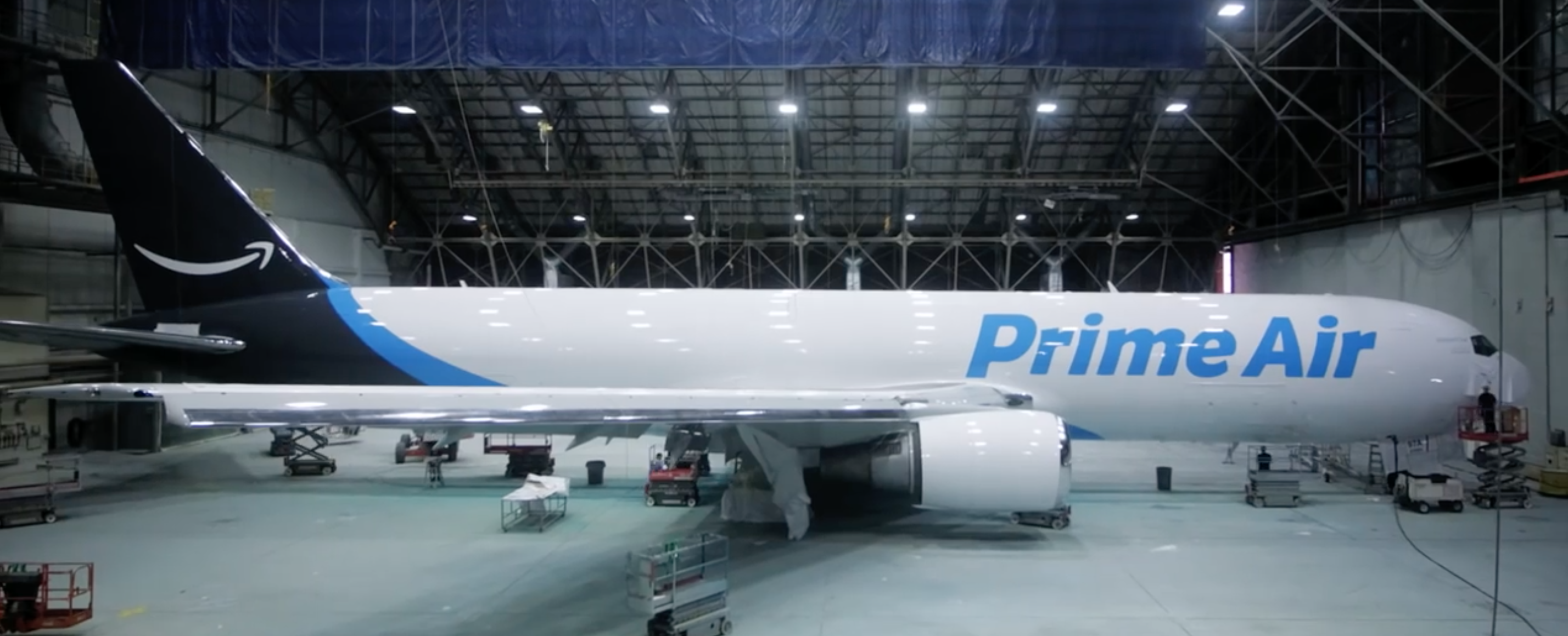Amazon “Prime Air” Planes Fly Full, But Lighter And Later

Amazon has essentially changed the way millions of people get packages. Now that they’re in the airplane business they’re even more fascinating to me as a logistics company.
I wanted to share an interesting article that David H brought to my attention. It reveals some interesting tidbits about “Prime Air”. For starters, I wasn’t aware that the number of planes they’re operating had grown to 40. From a cargo standpoint, that’s a lot of lift.
Reuters notes a couple of other interesting points. Amazon’s planes are flying later in the evening than FedEx and UPS. And, they’re a lot lighter, even though they’re full:
Amazon aircraft on a monthly basis handled only between 37 percent and 52 percent of their maximum loads by weight, according to an analysis of cargo, capacity and landing data from the four airports, with supplementary information from tracking website FlightAware.com. By contrast, FedEx and UPS were at 53 percent and 56 percent capacity, respectively, according to U.S. Transportation Department data for the year ended September 2016, excluding weight carried for free.
Flight data shows another way that Amazon is departing from cargo companies’ road map in an attempt of its top goal: rapid delivery.
Using FlightAware.com and similar websites, Reuters tracked the schedules of Amazon contractors and verified with airports which flights were on behalf of the retailer.
Many of the company’s eastbound flights leave the states of Washington and California unusually late at night: its flight from Stockton to Wilmington, Ohio departs close to 2:00 AM Pacific Time (10:00 GMT), for instance. FedEx instead schedules most eastbound service no later than 9:00 PM (5:00 GMT) to ensure arrival at its Memphis, Tennessee hub in time for sorting packages overnight.
The article goes on to note that those FedEx and UPS flights need to head to their sorting facilities. This essentially turns them into “connecting flights” before the packages move on to their final destination.
That means Amazon can leave later and still get packages to the same place at roughly the same time, sometimes earlier.
The Final Two Pennies
I’m not really sure what to make of the data that Amazon seems to put lighter boxes on their planes. They’ve definitely got a sea of data. I’m just a little surprised that their modeling could be efficient enough this quickly to find an edge by carrying lighter boxes on their own planes. In some ways, I could see the opposite being true. It makes sense that Amazon’s agreements with FedEx and UPS being influenced by the weight of packages, even if their rates are rock bottom compared to what you and I pay to ship a box.
Targeting more direct flights that leave later in the evening seems right up their alley. That has the potential to be a huge boon for their business. Delivering packages more quickly than anyone else for very low prices is likely a great way to build customer loyalty.
FedEx and UPS are publicly held companies. If Amazon is starting to put a dent in their profitability, I suspect we’ll hear about it in the 1st quarter of 2017. It’s possible they might report about in for the 4th quarter of 2016. But I suspect they’re still at capacity for the holiday shopping season.
The post Amazon “Prime Air” Planes Fly Full, But Lighter And Later was published first on Pizza in Motion


UPS and FEDEX still move a lot of paper documents for businesses. This takes up less space, but more weight so their planes could be heavier. The envelopes are dense too, whereas Amazon has air pillows in most packages for added protection.
Greg, great point on the density of so many envelopes/paper for FedEx and UPS, versus the density of Amazon shipments.
Anybody in the shipping businesws is aware that pricing is based on weight and volume. Try shipping an empty box that is 39 inches cubed and it will be billed at hundreds of pounds. While there is an established rationale for these charges I suspect Amazon either has their own calculations or is just pressuring the big guys to bend.
Charles, that’s where I’m curious. I wonder if Amazon is just flexing muscle or using data better than others.
As an Amazon seller I can tell you Fedex is still slammed. I saw this coming long ago. Amazon will eventually build out their distribution network and cut ups and FedEx out. I saw the smartest thing one morning when I got a package Amazon prime. They sent a kid with a scanner probably making minimum to deliver my package. Very smart and way cheaper than a FedEx or UPS driver.
UnitedEF, I know FedEx and UPS still have plenty of business. Just not sure if Amazon’s moves affect it enough to report in quarterly earnings.
The point to point flying works fine when you only need to move goods between those points. And so far that’s all Amazon needs to do. That will only change if Amazon starts opening up more and smaller distributions points that it needs to stock. Amazon is just stock in warehouses, not moving goods to the last mile. It makes a huge difference in what the routing and loads look like.
Seth, agree. Amazon working with local “last mile” delivery companies is very different from Amazon getting their own fleet of vehicles.
Seth, is the size of the fleet new info? Last I recall they were at something like a dozen planes.
I often see all-white local delivery vans with Amazon markings. Don’t know if they are owned and operated by Amazon, or just contracted out.
swoopest, Amazon contracts with a variety of last-mile carriers (Laser Courier in our area, DC). To my knowledge they don’t lease/own any large number of delivery vehicles. They might have a small test somewhere I’m not aware of.
When a package gets hand off to the USPS, expect an extra 2 or 3 days before arrival. Last week, both the Fedex and UPS delivery drivers left all the packages at the apartment building office. I just wait for an email notice of delivery.
Kevin, USPS definitely not as efficient as even the local last-mile carriers.
Keep in mind Amazon still uses the other firms. Wouldn’t be surprised if Amazon utilizes its own fleet for items they get killed on dim weight vs actual weight yet still uses the other carriers for packages whose actual weight and dim weight are closer. That company is stupid smart and most importantly thorough. They look at absolutely everything and are what most people aspire to be when they supposedly think outside the box.
Jason, I agree they appear to analyze EVERYTHING. Super smart folks. That’s why I’m so curious if they figured out how to segregate packages so quickly.